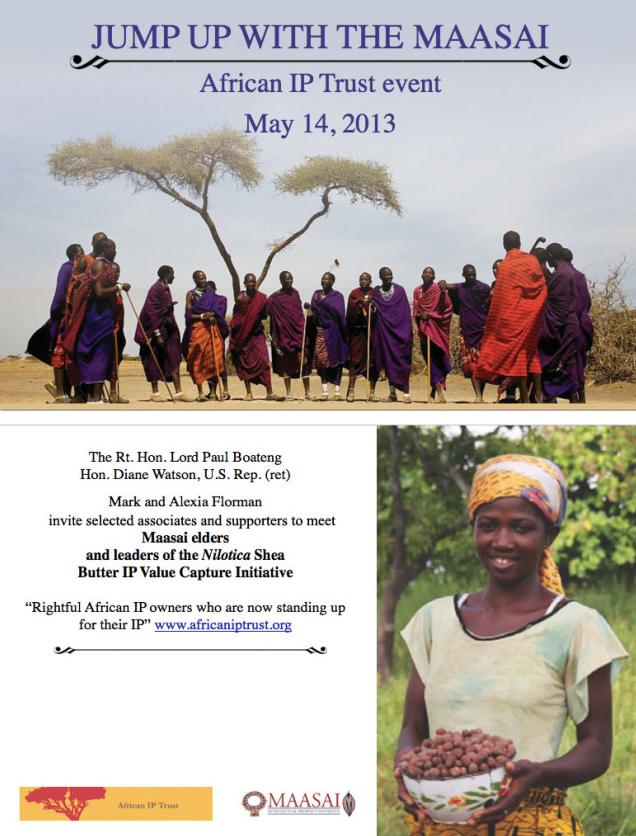
In a recent media report titled: “Maasai elders swap Kenya for Holborn Viaduct”, the global law firm Hogan Lovells has reportedly invited Maasai elders to the United Kingdom (UK) as part of its intellectual property (IP) pro bono work. As the report explains:
The firm has been doing intellectual property (IP) pro bono work, led by partner Sahira Khwaja, to try to secure a trademark for the tribe after the recognisable Maasai image has been used repeatedly used in advertising campaigns without any of the spoils making their way back to the tribe itself.
Lovells is working with Elders from the Maasai of Kenya and Tanzania through charity Light Years IP, which helps developing country producers win ownership of their intellectual property – should they choose to.
Light Years IP is a non-profit organization dedicated to alleviating poverty by assisting developing country producers gain ownership of their intellectual property and to use the IP to increase their export income and improve the security of that income. The Maasai Intellectual Property Initiative (MIPI) was founded by Light Years IP who designed a 7 point plan and IP strategies for the Maasai to achieve control over their iconic brand.
According to Light Years IP CEO, Ron Layton:
…the Maasai people have not yet decided on trademark ownership or appointment of Hogan Lovells to carry out trademark work. The Maasai elders are visiting London to obtain information to assist their community make such decisions. Above all, Light Years IP seeks for respect to be shown to the Maasai. Hogan Lovells are assisting Light Years IP in a range of work.
Comment:
First off, this blogger is ashamed that Kenya’s leading IP firms would rather religiously ‘network’ at International Trademark Association (INTA) Annual Meetings than take up worthy pro-bono IP matters such as MIPI.
The involvement of the UK in this matter is reminiscent of the “Kikoy” trademark row, which most are familiar with. In early 2008, a British company tried to register “Kikoy” as its trademark. The application would have given the company sole commercial rights to the term “Kikoy” – a corruption of “Kikoi”, the Kiswahili word for the distinctive colourful wrap skirts worn by men and women in East Africa. Thousands of East Africans were about to lose their livelihoods – and freedom to use a word from their language and condemn many to greater poverty. Kikoi has always been popular with visitors to resorts along the coasts of Kenya and Tanzania. According to a statement released by Traidcraft Exchange at the time, Ms Lisa Mann of Kisiki.com another UK company trading Kikoi products, first spotted the trademark application by the Kikoy Company UK Limited. Traidcraft Exchange passed on the news to a Nairobi based charity co-operation for fair Trade in Africa (COFTA), which mobilized its membership in 18 African countries and alerted KIPI. The move to register was halted by Traidcraft Exchange in conjunction with the UK law firm, Watson Burton (acting pro-bono), which filed a successful opposition to the registration on behalf of the Government of Kenya through the Kenya Industrial Property Institute (KIPI).
As Kenya embarks on the path toward sui-generis legislative framework for protection of TK held by our traditional communities, there remains a lot of work that can be done within the IP system. Instead of always heaping blame on the government for not doing enough, it is high time the private sector played its role in promotion and protection of traditional cultural products. An important activity that needs to carried out almost continuously is awareness creation and sensitisation. Raising awareness of local communities on identification of intellectual property assets is crucial as it allows them to use the necessary IP tools to secure them and commercialise them.
There is a need for us to enhance, support and assist the government’s efforts in the promotion of the cultural heritage of Kenya including encouraging, preserving, sustaining and disseminating knowledge of traditional and contemporary tangible culture. Collectively, we should all be committed to the protection, preservation and even retrieval of important objects of tangible traditional culture including which bear witness to the antiquity of Kenya.